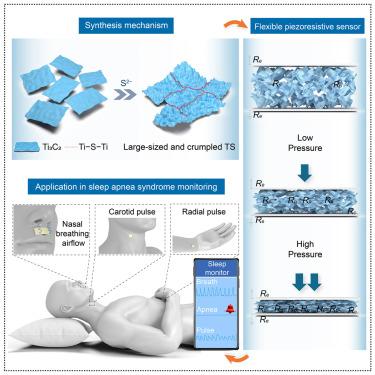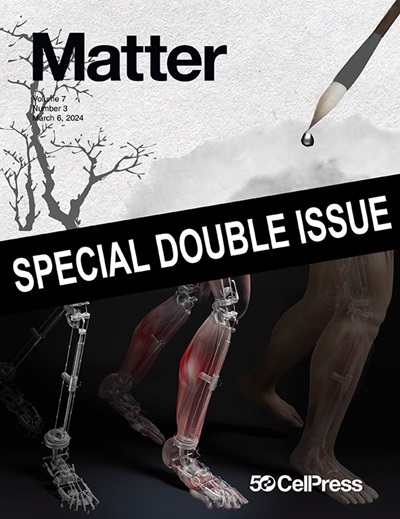Atomic sulfur-bonded titanium carbide nanosheets for flexible piezoresistive sensor in monitoring sleep apnea syndrome
IF 17.5
1区 材料科学
Q1 MATERIALS SCIENCE, MULTIDISCIPLINARY
引用次数: 0
Abstract
Flexible piezoresistive sensors have attracted great attention for the real-time monitoring of sleep apnea syndrome (SAS) through respiratory airflow. Although two-dimensional ultrathin Ti3C2 is regarded as a promising piezoresistive material, its poor structural compressibility and antioxidation limit its practical applications. Here, an innovative atomic sulfur-bonded strategy is proposed to fabricate large-sized, crumpled, and antioxidative Ti3C2/Na2S (TS) flakes for preparing flexible piezoresistive sensors. The fundamental mechanism is rooted in the synergistic effect of lateral boundary assembly of Ti3C2 nanosheets into large flakes (∼7 μm), lattice distortion to induce crumpled structures, and edge passivation by S2− ions to mitigate oxidation (105 days). The crumpled microstructure provides abundant voids for enhanced compressibility and contact site variability, resulting in a 5-fold sensitivity improvement over the Ti3C2 sensor and an ultralow detection limit of 0.2 Pa. We demonstrate the practical application of highly sensitive and stable piezoresistive sensors integrated into a respiratory monitoring system for SAS detection.


原子硫键合碳化钛纳米片用于监测睡眠呼吸暂停综合征的柔性压阻传感器
柔性压阻传感器通过呼吸气流对睡眠呼吸暂停综合征(SAS)进行实时监测,引起了人们的广泛关注。虽然二维超薄Ti3C2被认为是一种很有前途的压阻材料,但其较差的结构压缩性和抗氧化性限制了其实际应用。本文提出了一种创新的原子硫键策略,用于制备柔性压阻传感器的大尺寸、皱褶和抗氧化Ti3C2/Na2S (TS)薄片。其基本机制是基于Ti3C2纳米片的横向边界组装成大薄片(~ 7 μm),晶格畸变诱导皱褶结构,以及S2−离子的边缘钝化以减轻氧化(105天)的协同效应。褶皱的微结构提供了丰富的空间,增强了可压缩性和接触部位的可变性,从而使灵敏度比Ti3C2传感器提高了5倍,并具有0.2 Pa的超低检测极限。我们演示了高灵敏度和稳定的压阻式传感器集成到呼吸监测系统中用于SAS检测的实际应用。
本文章由计算机程序翻译,如有差异,请以英文原文为准。
求助全文
约1分钟内获得全文
求助全文
来源期刊

Matter
MATERIALS SCIENCE, MULTIDISCIPLINARY-
CiteScore
26.30
自引率
2.60%
发文量
367
期刊介绍:
Matter, a monthly journal affiliated with Cell, spans the broad field of materials science from nano to macro levels,covering fundamentals to applications. Embracing groundbreaking technologies,it includes full-length research articles,reviews, perspectives,previews, opinions, personnel stories, and general editorial content.
Matter aims to be the primary resource for researchers in academia and industry, inspiring the next generation of materials scientists.
文献相关原料
公司名称
产品信息
阿拉丁
Lithium fluoride (LiF)
阿拉丁
Sodium hydrosulfide (NaHS)
阿拉丁
Dimethyl sulfoxide (DMSO)
阿拉丁
Lithium fluoride
阿拉丁
Sodium hydrosulfide
阿拉丁
Dimethyl sulfoxide
阿拉丁
Lithium fluoride (LiF)
阿拉丁
Sodium hydrosulfide (NaHS)
阿拉丁
Dimethyl sulfoxide (DMSO)
 求助内容:
求助内容: 应助结果提醒方式:
应助结果提醒方式:


